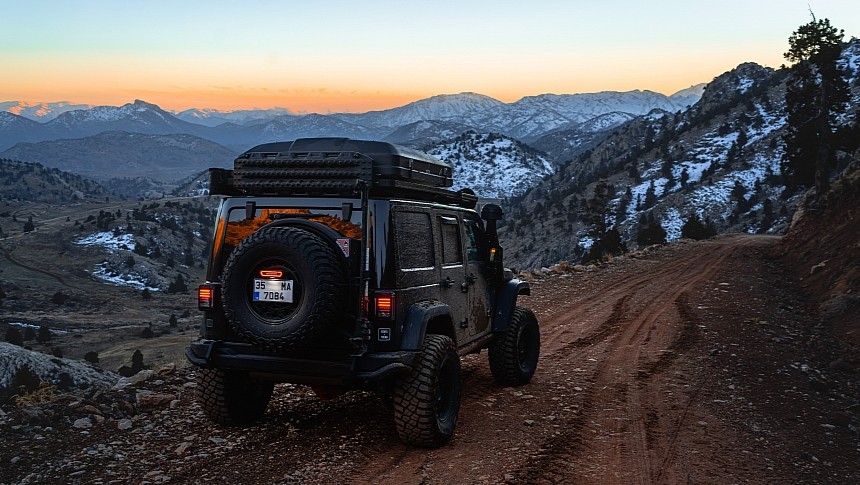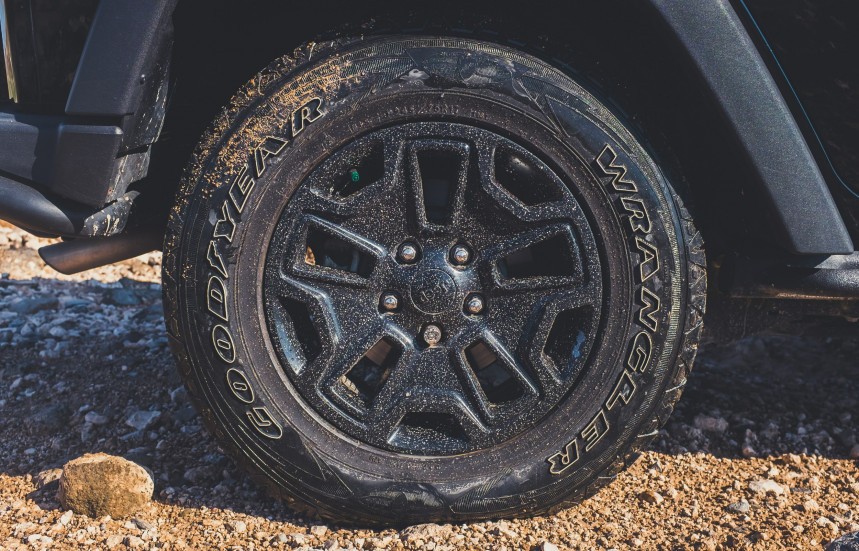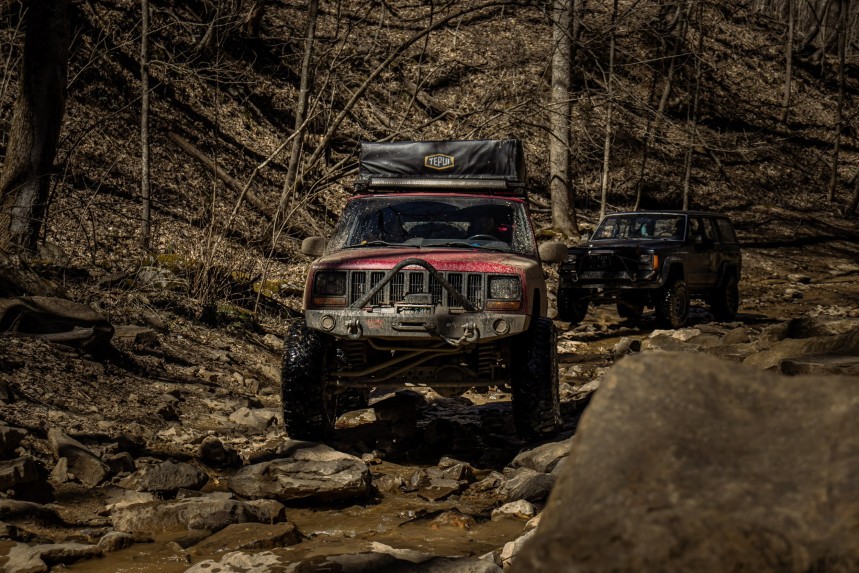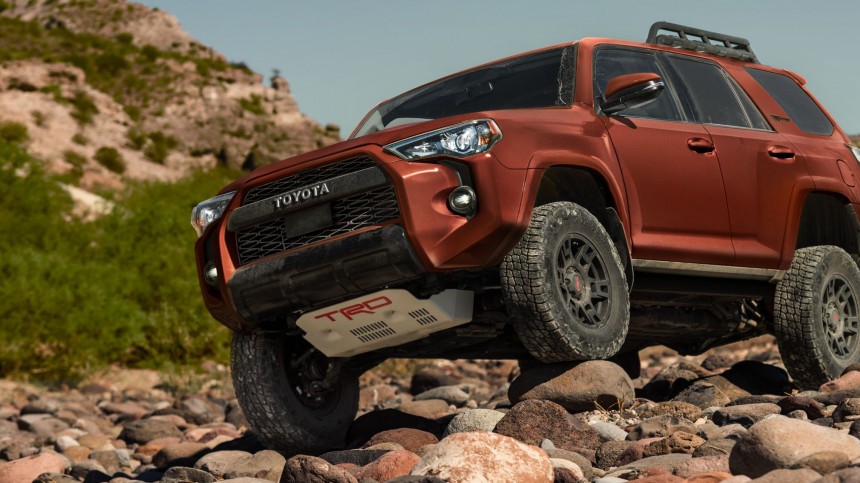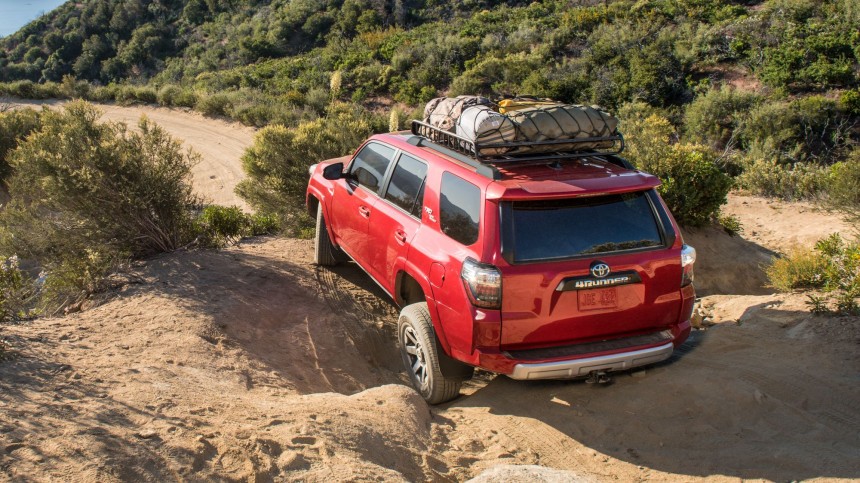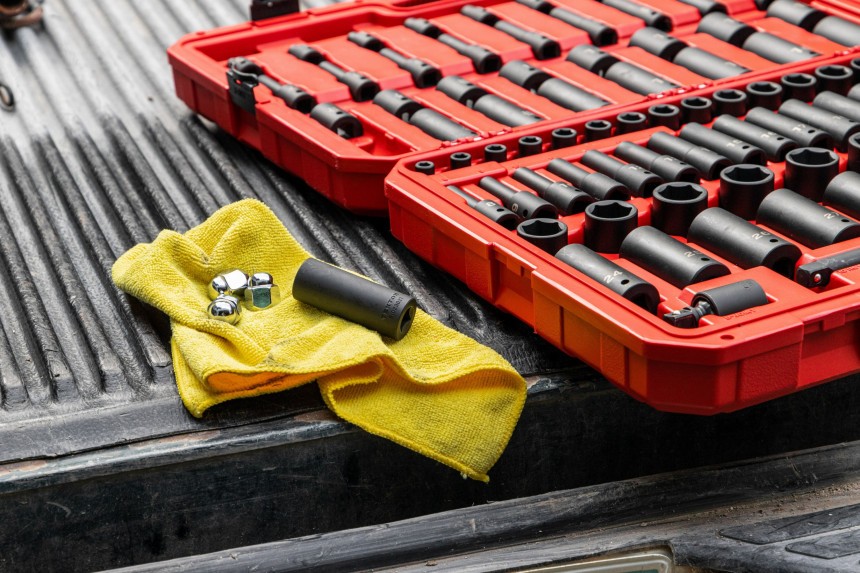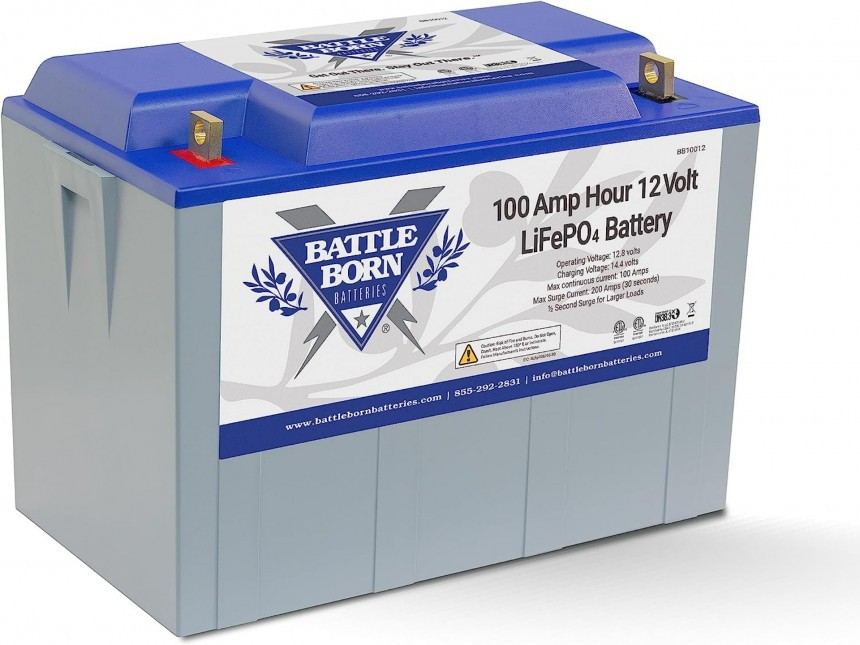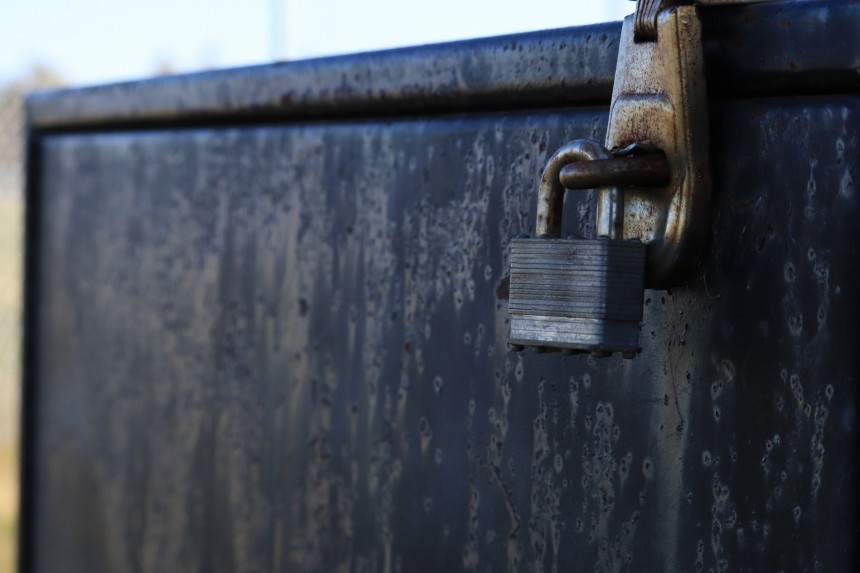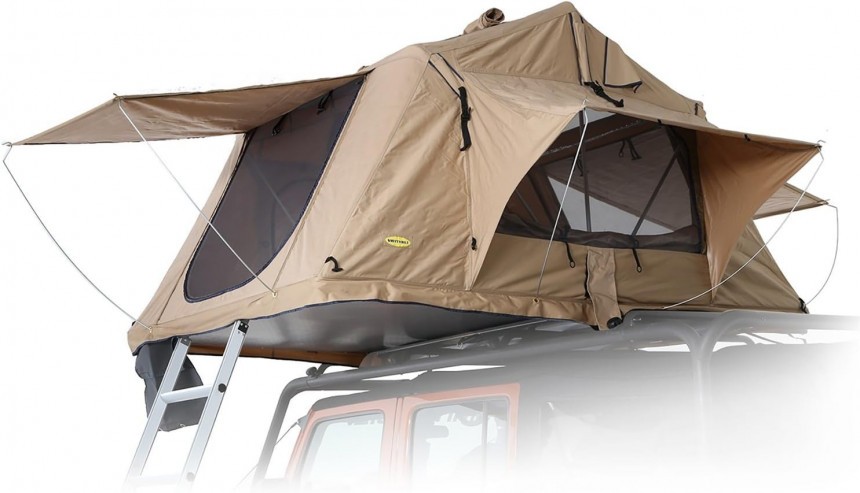Building an overlander might feel overwhelming, but anyone can do it with the right preparation. The first step is choosing the ideal vehicle for your needs. Although many cars come with excellent stock overlanding qualities, the best overlander rigs will feature some aftermarket modifications that allow you to embark on all-out adventures. And that's our topic for this article: how to build and customize your ultimate overlanding beast.
Previously, I broke down what makes an excellent overland vehicle and I also suggested the best cars you can buy that can be outfitted to become overlanders. Now, let’s talk about the upgrades and accessories that turn a candidate car into the real thing.
Wheels and tires are one of the most important parts of any overland build. Depending on your base vehicle, you'll have to consider the tire size and design, as well as using the right wheel.
If you go for any of the cars I listed in the previous article, you'll already have a set of performant stock wheels. Believe it or not, staying stock can also be a good option, as the stock wheels undergo rigorous testing before being available to the public.
That being said, it's also worth exploring other wheels and tires. Wider wheels provide better traction. But hardcore off-road tires are noisier and don't offer the same amount of grip on tarmac. Furthermore, opting for smaller diameter wheels, such as 17" and 18" instead of 20", allows you to mount tires with thicker sidewalls.
Another reason to upgrade your wheels is aesthetics: for some people, it's not enough to have impressive performance – they also want a beastly-looking rig. One way to achieve that is to go wild and choose distinctive designs, colors, and dimensions.
When it comes to steel vs aluminum, it’s quite simple. Steel wheels are inexpensive and can be easily repaired. But aluminum wheels are typically the better choice, as they’re lighter, offer good rigidity, and dissipate heat better.
Another critical component for an overlander build is the suspension. When it comes to ground clearance, all ten vehicles I presented in the last article get the green light – they're positioned high enough for you not to worry in many off-road environments.
If your overlanding expedition involved lighter off-roading and cruising through maintained roads, you don't need a suspension upgrade. But if you dream of tackling more rugged trails, you'll need one, especially if you're also hauling lots of cargo.
That brings me to my next point: weight. You must know how much gear you'll carry, as the suspension system will need to hold the load and absorb the impact along the way. If you plan on bringing a heavier load, consider considering disconnectable sway bars and spring upgrades.
If you add a lift to your overlander, it's even more important to have the right suspension components. The higher the vehicle, the more it will rock and sway.
So, let me briefly present the types of suspension kits. First off, we have the suspension lift kit. Just as its name suggests, this upgrade will simply increase the height of the body of your vehicle from the ground. Most offer from 2 to 8 inches (5 to 20 centimeters) of extra height. Besides the higher ground clearance, you get better visibility, a smoother ride, and more space to fit larger tires.
One straightforward and more affordable upgrade is leaf springs. Long story short, they make a significant difference to your off-roading experience by absorbing the pressure when the vehicle's axle moves, reducing shock from tougher road conditions.
And lastly, we have shock – these hydraulic cylinders absorb vibrations from your tires and make your ride smoother when off the beaten path. They will change how your overlander feels in all conditions, whether you accelerate brake, turn a corner, or crawl on rocks. What's more, they can fine-tuned to fit your exact needs.
These come in two options: auxiliary tanks and replacement tanks. An auxiliary tank is connected to the vehicle's stock fuel tank. It's typically mounted either underneath or on top of the car. The cool thing about some of these tanks is that they enable you to fill on the go. Just press a button, and it will start transferring the dinosaur juice into the main tank.
If the auxiliary tank sounds too complicated, you could replace the original fuel tank with a larger one, which can provide twice the range capacity – of course, that depends on the exact car model and how much real estate you have on it.
Of course, the easiest solution would be to add jerry cans to your rig for extra fuel storage. For safety reasons, it's best to carry them on the exterior of your vehicle. While there are many spots available, one of the best would be near the rear bumper - try to avoid storing them on the roof to minimize the risk of spills.
Most overlanding-ready vehicles will come with some sort of body armor, whether it's skid plates, sliders, or something else. These components are designed to provide additional strength and durability for your vehicle,
A must for your overlander is a proper front bumper, as damage typically occurs at the front. Whether it's a minor fender bender or a more severe impact, the bumper will protect the headlights and radiator.
However, a well-designed front bumper will not only keep you safe but also offer extra ground clearance and a greater approach angle. What's more, if you decide on an aftermarket front bumper, keep an eye out whether it comes with winch mounting plates, auxiliary light mounts, or recovery points.
When discussing rear bumpers, the focus shifts from protection to other benefits, such as storage capabilities. One of the best options you could go for is a swing-out rear bumper, which will offer more storage options and a place to mount your spare tire. Being a swing-out, you can move it out of the way whenever you need to access the vehicle's rear.
And lastly, we have sliders and skid plates. If you plan on rock crawling in your overlander, sliders are a must. There are many options available, such as bolt-on or weld-on rock sliders.
Skid plates protect the engine oil pan, transfer case, and transmission from outside damage. There are a myriad of options available, including skid plates for other components, such as the fuel tank or differentials.
If your overlanding adventure is more on the lighter side, the factory skid plates will probably do the job. But if you're gearing up for extreme off-roading, an aftermarket steel skid plate will keep you worry-free. As a general rule, steel will provide more protection than aluminum and is less expensive, the only downside being the increased weight.
Pretty much everything you'll do while overlanding requires some sort of gear. That's why there's no such thing as too much storage on an overlander. There are countless options regarding storage equipment for cars, but I'll keep things as short and sweet as possible.
One go-to option for overlander storage is cases – whether aluminum or plastic; cases are a fantastic solution for smaller equipment. They can be stored either inside or outside the vehicle, allowing you to organize your gear neatly.
Similarly, soft bags and pouches are a popular option, as they can be folded and stored out of the way. Of course, they're more suitable for indoor storage.
Molle panels are another great way of customizing your vehicle for additional storage. Molle stands for "Modular Lightweight Load-carrying Equipment" - it's a versatile and secure mounting system consisting of an organizational grid.
These panels are typically fabricated from aluminum or steel, and they enable you to easily and safely mount your gear inside and outside your rig.
Another way of increasing the available storage space is by adding a roof rack. There are many roof rack options available, such as cross bars, rails, and racks. They fulfill the same purpose of providing additional space.
So, what should you consider when purchasing a roof rack? First of all, make sure it can fit your vehicle. Then, find out how much your car's roof can hold, as passing that limit can damage your vehicle.
What type of stuff will you haul on it? If you're looking to set up a rooftop tent or carry bikes, you'll need a particular type of roof rack. Another key point is the material it's made out of – check its durability and whether it is rust-resistant.
And lastly, consider the aerodynamics and height of the rack – this point is especially important if your adventure involves lots of pavement driving. A large roof rack will impact your vehicle's aerodynamics and change how it feels at high speeds.
Moreover, you don't want to increase your vehicle height too much when adding a roof rack, especially if you already have a high ground clearance. That's because the vehicle's center of gravity will shift, thus impacting your handling in off-road situations.
It's impossible to go overlanding and not run into any mechanical issue whatsoever – that's why it's critical to be prepared and bring a kit that includes some essential tools that can be used for basic trail repairs and recoveries.
Of course, the exact tools you'll need depend on what type of vehicle you're driving. Still, there are several categories when it comes to essential overlanding tools.
First off, we have maintenance tools, the ones that will allow you to carry out basic trail repairs. You can bring an adjustable wrench, an Allen key, a socket set, various screwdrivers, a drill, and a set of spanners, to name a few.
Next, you'll need to be prepared for any electrical problems you might encounter. That's why you should bring along some electrical tools, a multimeter, electrical tape, wires, as well as relays and fuses. Furthermore, an OBD meter is a good addition.
Equipping your overlander with a winch will make a significant difference when you're stuck. However, it doesn't hurt to pack a good-quality recovery strap or a kinetic rope.
One of the more common issues you might run into is tire flats. A good tire repair kit isn't that expensive – even if it were, it would still be an excellent investment. If you need to fit your spare tire, it would be helpful to have a tire lever. Oh, don't forget about a compact air compressor, as it will save your day when the time comes.
You can also pack some miscellaneous tools/equipment, such as a headlamp, lighters, utility knives, as well as fluids and replacement parts. I almost forgot about a fire extinguisher – you shouldn't embark on your overlanding adventure without one.
If you want to head off the grid, even for a shorter period, you'll need a power source. The three most common battery types are flooded lead-acid, absorbed glass mat (AGM), and lithium (Li-Ion).
The best option for overlanding is a lithium battery pack. Why is that? They're lightweight, durable, and charge faster than the other types. Furthermore, they can be discharged much deeper than lead acid batteries, meaning you can use more power in your system. Lithium-ion batteries also have a much longer lifespan.
The only downside is the price – you'll have to pay considerably more, but it's worth the investment. For additional power, you can connect the batteries to solar panels.
The best practice would be to use a dual-battery system. This way, you can hook up your starting battery for the basic functions of the vehicle, as well as for your communication devices and driving lights.
All the remaining accessories can then be powered by the auxiliary battery. Keep in mind that these two batteries would have to be of the same chemistry; if you decide to run mixed chemistry, you'll need a battery management system.
Even if you're heading toward an incredibly remote spot, you shouldn't assume you won't run into ill-intended people. So, why not equip your overlander with several security features? You don't need to go wild with them, just enough to keep you safe.
But first, let me tell you some tips and tricks to prevent someone from breaking into your tiny home on wheels. It might be common sense, but I'll still say it: try to park in a safe place, such as a campsite or a hotel.
Another tip is to keep your stuff out of sight and, thus, out of mind. The less you show your expensive gear, the lower the chances of someone robbing you. You can use compartments and other storage solutions to tuck away your stuff. Moreover, a window tint might prove useful, as people will have a harder time peeking inside.
After doing all that, you can opt for additional security measures, such as locks – you'll find a product that protects everything you have on your rig, be it a toolbox, roof tent, or spare wheel.
Sleeping in the vehicle is often not the most comfortable solution. Having some sort of shelter or sleeping location will significantly improve your overlanding experience, especially if you're not traveling by yourself. Two of the most popular options are tents and camper shells.
Regarding tents, you could opt for a rooftop-mounted one, but simple ground tents shouldn't be overlooked. However, rooftop tents are faster and easier to mount compared to conventional ground tents. Moreover, because they're permanently mounted on top of your vehicle, you'll have some extra storage space inside for more gear. And lastly, they keep you off the ground, meaning you'll be safe from muddy and wet surfaces and from curious animals and insects.
There are two types of tents available: soft-top and hard-top. Let me quickly touch upon both – the soft variants offer lots of room for occupants and typically come with built-in awning systems. Furthermore, they weigh less and cost less than hard-top tents. However, they take longer to set up and don't withstand weather conditions, as well as hard-top ones.
Hard-top tents are easy to set up and take down and are typically more aerodynamic. Moreover, high-quality ones will provide better weather protection and sometimes insulation. They often come with built-in mattresses. On the other hand, they're typically not as spacious as fost-top variants and are way more expensive.
If these options are not enough, you could upgrade to a truck camper sleep system – these units are more prominent and offer more comfort via various utilities, such as a fridge, water tanks, batteries, and more. However, they're the most expensive option in the class, are very heavy, and create lots of drag when driving.
Regardless of how much you prepare, the best way of figuring out what you need is by actually doing it. Don't just take a stranger's advice from the Internet – take a day or two to overland in your local environment, as it might prove to be more of an enlightening experience.
Wheels and Tires
If you go for any of the cars I listed in the previous article, you'll already have a set of performant stock wheels. Believe it or not, staying stock can also be a good option, as the stock wheels undergo rigorous testing before being available to the public.
That being said, it's also worth exploring other wheels and tires. Wider wheels provide better traction. But hardcore off-road tires are noisier and don't offer the same amount of grip on tarmac. Furthermore, opting for smaller diameter wheels, such as 17" and 18" instead of 20", allows you to mount tires with thicker sidewalls.
Another reason to upgrade your wheels is aesthetics: for some people, it's not enough to have impressive performance – they also want a beastly-looking rig. One way to achieve that is to go wild and choose distinctive designs, colors, and dimensions.
When it comes to steel vs aluminum, it’s quite simple. Steel wheels are inexpensive and can be easily repaired. But aluminum wheels are typically the better choice, as they’re lighter, offer good rigidity, and dissipate heat better.
Suspension
If your overlanding expedition involved lighter off-roading and cruising through maintained roads, you don't need a suspension upgrade. But if you dream of tackling more rugged trails, you'll need one, especially if you're also hauling lots of cargo.
That brings me to my next point: weight. You must know how much gear you'll carry, as the suspension system will need to hold the load and absorb the impact along the way. If you plan on bringing a heavier load, consider considering disconnectable sway bars and spring upgrades.
If you add a lift to your overlander, it's even more important to have the right suspension components. The higher the vehicle, the more it will rock and sway.
So, let me briefly present the types of suspension kits. First off, we have the suspension lift kit. Just as its name suggests, this upgrade will simply increase the height of the body of your vehicle from the ground. Most offer from 2 to 8 inches (5 to 20 centimeters) of extra height. Besides the higher ground clearance, you get better visibility, a smoother ride, and more space to fit larger tires.
One straightforward and more affordable upgrade is leaf springs. Long story short, they make a significant difference to your off-roading experience by absorbing the pressure when the vehicle's axle moves, reducing shock from tougher road conditions.
And lastly, we have shock – these hydraulic cylinders absorb vibrations from your tires and make your ride smoother when off the beaten path. They will change how your overlander feels in all conditions, whether you accelerate brake, turn a corner, or crawl on rocks. What's more, they can fine-tuned to fit your exact needs.
Fuel Tanks
As I mentioned in the previous article, fuel economy is a crucial point to consider when choosing a base overlanding vehicle. For most people, the stock fuel carrying capabilities will be more than enough. But if you're tired of constant fill-ups and you're preparing for a journey where you won't encounter many gas stations, one way of making sure you don't run out of fuel is by fitting an extra fuel tank.These come in two options: auxiliary tanks and replacement tanks. An auxiliary tank is connected to the vehicle's stock fuel tank. It's typically mounted either underneath or on top of the car. The cool thing about some of these tanks is that they enable you to fill on the go. Just press a button, and it will start transferring the dinosaur juice into the main tank.
If the auxiliary tank sounds too complicated, you could replace the original fuel tank with a larger one, which can provide twice the range capacity – of course, that depends on the exact car model and how much real estate you have on it.
Of course, the easiest solution would be to add jerry cans to your rig for extra fuel storage. For safety reasons, it's best to carry them on the exterior of your vehicle. While there are many spots available, one of the best would be near the rear bumper - try to avoid storing them on the roof to minimize the risk of spills.
Body Armor
A must for your overlander is a proper front bumper, as damage typically occurs at the front. Whether it's a minor fender bender or a more severe impact, the bumper will protect the headlights and radiator.
However, a well-designed front bumper will not only keep you safe but also offer extra ground clearance and a greater approach angle. What's more, if you decide on an aftermarket front bumper, keep an eye out whether it comes with winch mounting plates, auxiliary light mounts, or recovery points.
When discussing rear bumpers, the focus shifts from protection to other benefits, such as storage capabilities. One of the best options you could go for is a swing-out rear bumper, which will offer more storage options and a place to mount your spare tire. Being a swing-out, you can move it out of the way whenever you need to access the vehicle's rear.
And lastly, we have sliders and skid plates. If you plan on rock crawling in your overlander, sliders are a must. There are many options available, such as bolt-on or weld-on rock sliders.
Skid plates protect the engine oil pan, transfer case, and transmission from outside damage. There are a myriad of options available, including skid plates for other components, such as the fuel tank or differentials.
If your overlanding adventure is more on the lighter side, the factory skid plates will probably do the job. But if you're gearing up for extreme off-roading, an aftermarket steel skid plate will keep you worry-free. As a general rule, steel will provide more protection than aluminum and is less expensive, the only downside being the increased weight.
Storage
One go-to option for overlander storage is cases – whether aluminum or plastic; cases are a fantastic solution for smaller equipment. They can be stored either inside or outside the vehicle, allowing you to organize your gear neatly.
Similarly, soft bags and pouches are a popular option, as they can be folded and stored out of the way. Of course, they're more suitable for indoor storage.
Molle panels are another great way of customizing your vehicle for additional storage. Molle stands for "Modular Lightweight Load-carrying Equipment" - it's a versatile and secure mounting system consisting of an organizational grid.
These panels are typically fabricated from aluminum or steel, and they enable you to easily and safely mount your gear inside and outside your rig.
Another way of increasing the available storage space is by adding a roof rack. There are many roof rack options available, such as cross bars, rails, and racks. They fulfill the same purpose of providing additional space.
So, what should you consider when purchasing a roof rack? First of all, make sure it can fit your vehicle. Then, find out how much your car's roof can hold, as passing that limit can damage your vehicle.
What type of stuff will you haul on it? If you're looking to set up a rooftop tent or carry bikes, you'll need a particular type of roof rack. Another key point is the material it's made out of – check its durability and whether it is rust-resistant.
And lastly, consider the aerodynamics and height of the rack – this point is especially important if your adventure involves lots of pavement driving. A large roof rack will impact your vehicle's aerodynamics and change how it feels at high speeds.
Moreover, you don't want to increase your vehicle height too much when adding a roof rack, especially if you already have a high ground clearance. That's because the vehicle's center of gravity will shift, thus impacting your handling in off-road situations.
Tools/Equipment
Of course, the exact tools you'll need depend on what type of vehicle you're driving. Still, there are several categories when it comes to essential overlanding tools.
First off, we have maintenance tools, the ones that will allow you to carry out basic trail repairs. You can bring an adjustable wrench, an Allen key, a socket set, various screwdrivers, a drill, and a set of spanners, to name a few.
Next, you'll need to be prepared for any electrical problems you might encounter. That's why you should bring along some electrical tools, a multimeter, electrical tape, wires, as well as relays and fuses. Furthermore, an OBD meter is a good addition.
Equipping your overlander with a winch will make a significant difference when you're stuck. However, it doesn't hurt to pack a good-quality recovery strap or a kinetic rope.
One of the more common issues you might run into is tire flats. A good tire repair kit isn't that expensive – even if it were, it would still be an excellent investment. If you need to fit your spare tire, it would be helpful to have a tire lever. Oh, don't forget about a compact air compressor, as it will save your day when the time comes.
You can also pack some miscellaneous tools/equipment, such as a headlamp, lighters, utility knives, as well as fluids and replacement parts. I almost forgot about a fire extinguisher – you shouldn't embark on your overlanding adventure without one.
Lithium Batteries
The best option for overlanding is a lithium battery pack. Why is that? They're lightweight, durable, and charge faster than the other types. Furthermore, they can be discharged much deeper than lead acid batteries, meaning you can use more power in your system. Lithium-ion batteries also have a much longer lifespan.
The only downside is the price – you'll have to pay considerably more, but it's worth the investment. For additional power, you can connect the batteries to solar panels.
The best practice would be to use a dual-battery system. This way, you can hook up your starting battery for the basic functions of the vehicle, as well as for your communication devices and driving lights.
All the remaining accessories can then be powered by the auxiliary battery. Keep in mind that these two batteries would have to be of the same chemistry; if you decide to run mixed chemistry, you'll need a battery management system.
Security
But first, let me tell you some tips and tricks to prevent someone from breaking into your tiny home on wheels. It might be common sense, but I'll still say it: try to park in a safe place, such as a campsite or a hotel.
Another tip is to keep your stuff out of sight and, thus, out of mind. The less you show your expensive gear, the lower the chances of someone robbing you. You can use compartments and other storage solutions to tuck away your stuff. Moreover, a window tint might prove useful, as people will have a harder time peeking inside.
After doing all that, you can opt for additional security measures, such as locks – you'll find a product that protects everything you have on your rig, be it a toolbox, roof tent, or spare wheel.
Shelter
Regarding tents, you could opt for a rooftop-mounted one, but simple ground tents shouldn't be overlooked. However, rooftop tents are faster and easier to mount compared to conventional ground tents. Moreover, because they're permanently mounted on top of your vehicle, you'll have some extra storage space inside for more gear. And lastly, they keep you off the ground, meaning you'll be safe from muddy and wet surfaces and from curious animals and insects.
There are two types of tents available: soft-top and hard-top. Let me quickly touch upon both – the soft variants offer lots of room for occupants and typically come with built-in awning systems. Furthermore, they weigh less and cost less than hard-top tents. However, they take longer to set up and don't withstand weather conditions, as well as hard-top ones.
Hard-top tents are easy to set up and take down and are typically more aerodynamic. Moreover, high-quality ones will provide better weather protection and sometimes insulation. They often come with built-in mattresses. On the other hand, they're typically not as spacious as fost-top variants and are way more expensive.
If these options are not enough, you could upgrade to a truck camper sleep system – these units are more prominent and offer more comfort via various utilities, such as a fridge, water tanks, batteries, and more. However, they're the most expensive option in the class, are very heavy, and create lots of drag when driving.
Conclusion
Hopefully, I was able to shed some light regarding what it takes to build your ultimate overlander. At the end of the day, it's your vehicle, so you should go for the modifications that best suit your future travels.Regardless of how much you prepare, the best way of figuring out what you need is by actually doing it. Don't just take a stranger's advice from the Internet – take a day or two to overland in your local environment, as it might prove to be more of an enlightening experience.
